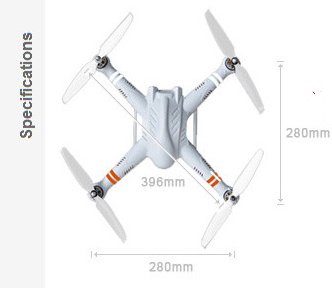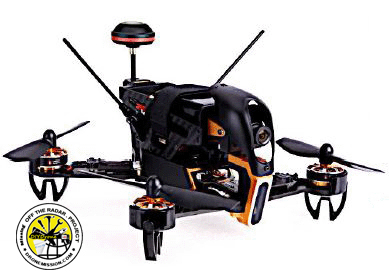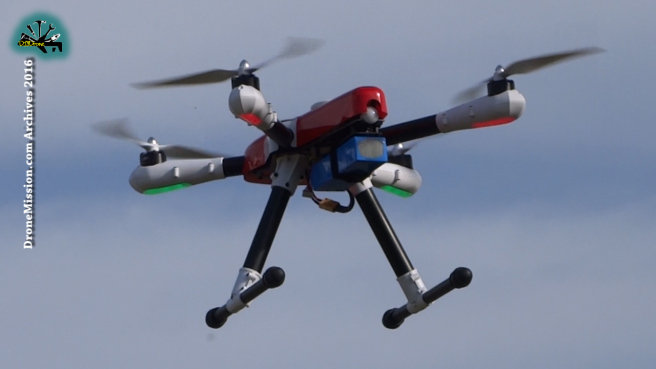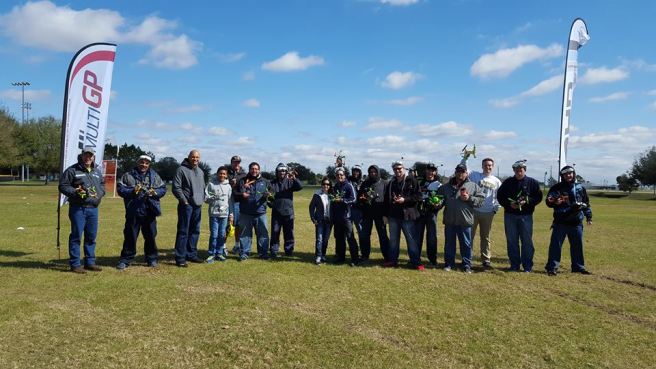Category Archives: Multirotors
FreeX MCFX-01 Drone

FreeX MCFX ! It seems like the FreeX is being revived, now the 4.0 edition, in a nut shell reading the specs, what caught my eyes are:
- Lost signal: Automatic return or hover at last known position
- Reduces speed as it approaches launch point during return home, when near 80m
- Stock Range: 1 km
- Onetouch4 configuration tool software
- Channels: 7
- 6 Axis Gyro
- FREE quality 2-axis gimbal with pitch control
- Estimated price: $200!
 History
History
FreeX is not new in the market, the SkyView has been in the market since 2014, marketed and backed by several prominent labels such as OFM, Xaircraft, manufactured by Skyartec ; along the way, Firmware V4 was released. I am not sure what else is different, but read on for everyone’s updates in the coming weeks.
JJRC H28C Camera Drone

JJRC unique quadcopter design with a detachable arms is welcome by many park flyers. The JJRC H28C comes ready to fly (RTF), propellers all assembled, with a 2.0MP camera, made to reduce transportation size. All you need is to reattach the arms and add the optional camera and landing skid to begin flying.
 First impression, the concept of detachable arms is great, but some hasty changes to accomplished the design, may require a second look and refinement. The arms are attached with classic t-plugs aka Deans connectors and hook on with side clips. The material used is light-weight Acrylonitrile Butadiene Styrene (ABS), a common thermoplastic polymer (also used by Lego). It is impact resistance, tough and heat resistance, but the interlocking joints weaken the structure and makes it vulnerable to break along the arms. The JJRC H28C quadcopter flies at moderate speed with a 2 cell 30c battery. Not really recommended for beginners, but if you are keen to learn this is a nice size quadcopter with protective guards. It is stable, you can do some nice turns with both sticks on a turn at the same time. It can handle moderate amount of wind outdoors…
First impression, the concept of detachable arms is great, but some hasty changes to accomplished the design, may require a second look and refinement. The arms are attached with classic t-plugs aka Deans connectors and hook on with side clips. The material used is light-weight Acrylonitrile Butadiene Styrene (ABS), a common thermoplastic polymer (also used by Lego). It is impact resistance, tough and heat resistance, but the interlocking joints weaken the structure and makes it vulnerable to break along the arms. The JJRC H28C quadcopter flies at moderate speed with a 2 cell 30c battery. Not really recommended for beginners, but if you are keen to learn this is a nice size quadcopter with protective guards. It is stable, you can do some nice turns with both sticks on a turn at the same time. It can handle moderate amount of wind outdoors…
Walkera F210 3D racing drone

Walkera does it again, taking the guesswork out of putting together a 3D racing quadcopter drone. F210 3D is a quadcopter with an optimized F3 flight controller paired with reversible electronic speed controller (ESC), allowing you to reverse the motor at mid point to fly upside down in a 3D manner. At flight mode 0 (FMOD=0 factory default) normal flight takes it toll 2D, flip the switch to FMOD=1, take-off in 3D mode, motor brakes and reverses at mid-point.
 F210 3D is upgraded with faster receiver response time, stronger frame, and superior low lux Sony HD camera. Pre-installed with a 5.8 gHz video transmitter and On Screen Display (OSD) to assist pilot in flying and replaying every favorite scene of a flight…
F210 3D is upgraded with faster receiver response time, stronger frame, and superior low lux Sony HD camera. Pre-installed with a 5.8 gHz video transmitter and On Screen Display (OSD) to assist pilot in flying and replaying every favorite scene of a flight…
Hubsan X4 PRO H109S Parachute
Finally the Hubsan H109S X4 PRO quadcopter to be officially released, maybe? We originally filmed the micro Hubsan x4 H107D that reached 350,000 views youtube very quickly back in 2013, so today I am back to take the X4 Pro for a DroneMission flight, at the same time provide some feedback on the new and improved X4 Pro. Since 2014 Hubsan has been talking about the x4 Pro H109S; along the way there were pre-releases, testing, and more testing. Two drone years in the making, will it live up to the reputation? The challenge is in 2 years, a lot can and have changed and Hubsan found themselves in the midst of an evolving technology, outdating applications and a price war in this industry.
To differentiate this pro quadcopter from it’s competitors, Hubsan included a Parachute System; when bumped in a collision, the parachute will automatically deploy to prevent the X4 Pro from crashing. Unlike other systems, the Hubsan parachute can be removed or assembled freely and be reused many times. When the canister tilt past 80 degrees, the sensor unlock the lid, and the spring pops the parachute out…
GTeng T901F Quadcopter

GTeng T901F is an unusual symmetrically spider-looking 16.5 cm outdoor quadcopter with a camera broadcasting at 5.8G frequency images transmission to your radio transmitter receiving monitor to view your flying. At 5.8gHz that would mean you can use your personal FPV goggle or any compatible external video receiver. The radio transmitter itself uses 2.4GHz to extend the range for outdoor flying and is powered by a 3.7V 500mA LiPo battery. Yes, you read it right, you get two chargers and two 3.7V 500mA LiPo battery out of the box, the second battery is to power the flying spider. The T901F carries a 6 axis gyro to ensure the stability and performance, allowing you to toss the quadcopter in the air and regain instant leveling.
 I can picture the GTeng T901F in a Sharper Image, nicely package, a mini quadcopter with copper trims around the body, ready to fly, out of the box. Everything is pre-assembled, weighing just 67 grams, legally within the limits before registration is required in the USA.
I can picture the GTeng T901F in a Sharper Image, nicely package, a mini quadcopter with copper trims around the body, ready to fly, out of the box. Everything is pre-assembled, weighing just 67 grams, legally within the limits before registration is required in the USA.
The 2 mega pixel camera captures and records video upto 300 meters (our tests under 70 meters) in real-time transmission while you view it from the radio. T901F comes with the popular headless mode, basic one key automatic return function without GPS and 360 degree flip functions…
Navgator X6 Xinlin X181

The Navgator X6 Xinlin X181 quadcopter was released recently and is hard not to get excited about this model aircraft. The Navgator X6 can fly, in fact very swift and aerobatic! Xinlin Shiye is not new in the radio control scene, Best Buy and Sears were among their major buyers, during the explosive 2015 drone sales.
 To differentiate from other quadcopters, Xinlin Shiye included a radio transmitter with LCD. The highlights to this model, are the 5.8G FPV 2MP 720P camera and a 5 inch LCD video/DVR receiver screen that provides real-time video viewing and photo capturing.
To differentiate from other quadcopters, Xinlin Shiye included a radio transmitter with LCD. The highlights to this model, are the 5.8G FPV 2MP 720P camera and a 5 inch LCD video/DVR receiver screen that provides real-time video viewing and photo capturing.
I absolutely love how this Navgator x6 flies, compared to my other 20-25cm quadcopters. The motors and battery gets hot during a 7 minutes flights, but not a concern, powerful enough to flip and take some nice turns…
Syma X5HW WIFI Quadcopter
X5HW made by Syma introduces the next generation of budget mini quadcopters with barometer sensors for Altitude Hold. Pressure sensors are not new to the quadcopter drones scene but not many mini copters carry them.
First impression, this quadcopter is a great beginner’s budget quadcopter. Number 1, dual arming protocol prevents a newbie from accidentally bumping the throttle and spinning up the blades. Number 2, two gear speed, Low (L) rates from indoors flights and High (H) rates for outdoors and windy conditions. Number 3, when the quadcopter encounters a direct impact or is struck on the propellers, the motors will shut off. Number 4, and best of all, it holds the altitude while the pilot focuses on forward flying.
 The Syma X5HW is easy to fly, stable, it does some nice bank turns. It can handle moderate amount of wind outdoors. It is small enough to fly indoors and comes with protective guards. The Android FPV WiFi app for Syma FPV connects instantly, photos and videos are viewable within the app.
The Syma X5HW is easy to fly, stable, it does some nice bank turns. It can handle moderate amount of wind outdoors. It is small enough to fly indoors and comes with protective guards. The Android FPV WiFi app for Syma FPV connects instantly, photos and videos are viewable within the app.
The range is limited to 50 meters and do suffers from some intermittent lost of control
Target Audience
Beginners, Off the shelves, Ready To Fly, Safety First, Park Flyer, Budget $60 (2016)
What To Expect If This Your First
You can easily spend 11 minutes on each flight, setting up and flying. The actual flight may last 5-7 minutes. On a Mode 2 radio transmitter, throttle stick is on the left.

Connect your battery to your quadcopter, close battery door and power on, lay the quadcopter flat on a hard surface immediately. This will allow the quadcopter to self-level the gyroscope. Power on your radio and move your left thottle stick up and down once to bind the receiver. When you are ready to fly, hold both sticks inwards to arm the motors, the propellers will begin to rotate slowly. The quadcopter is now live and has entered into flight preparation mode. To stop the motors, hold the left stick to the lowest point for 3 seconds.
The quadcopter LiPo battery may get a little warm after each flight. When the voltage is low, the quadcopter four lights will begin to blink and will begin to descent to prevent the battery from over-discharging. Over-discharging a LiPo battery below 3 volts per cell, can permanently damage the battery. It is best to let the LiPo cool down before the next charge.
You must set the speed to High (H) rates for outdoors.
With a 6-axis gyro flight controller, you can toss your quadcopter in the air and throttle up in full to self-level. Lower your throttle stick to about half once you regain control to hold the altitude. You will than need to yaw around to identify the front or back, to regain your orientation. If it helps, mark the back with red tape to make it more visible.
To complete an auto flip, fly to about 10 feet and press the top right button, and move the stick in the direction you want it to flip. It will auto flip!
If you lose radio signal, the quadcopter will drop, it would have been better if it descend slowly. Not by design, but as a last option, just power off, in an emergency if nothing else stops.
Don’t expect to be able to fly with the camera in first person view, as the camera lens view is rather narrow. The video also freezes when there is poor WIFI reception.
You may not be able to view the video recorded within your tablet if your equipment does not support 3GP playbacks. Video files are saved in 3GP format. 3GP is a video format specially developed for third generation mobile devices. You can view the video within the Syma App if your Gallery does not support 3GP or upload to goggle drive and view it there or use some other software.
Factory Specifications:
Color: White, Blue
Frequency : 2.4G
Channel : 4CH
Gyro:6 Axis
HD Camera:Photos(2MEGA), Video(1MEGA)
Battery for Quadcopter: 3.7V 600mAh Li-poly
Transmitter Battery: 4 x AA battery
Charging Time : About 90 mins (USB charging)
Flying time : About 5~7 minutes
Charging time:About 130 minutes
Controlling distance:About 30-50 meters
Product size:33*33*11cm
Box Size:41.5*34*9.5cm
 The propellers tend to break around the screw into half, as on impact the stress is placed on the screw on the shaft. Replacing the propellers are easy, but a handy screw driver is needed.
The propellers tend to break around the screw into half, as on impact the stress is placed on the screw on the shaft. Replacing the propellers are easy, but a handy screw driver is needed.
Features:
WIFI FPV with 2.0MP HD camera.
With Altitude Hold mode, setting height.
Headless mode, 360 roll.
6-Axis gyro flight, for stability, stronger wind resistance and easier control.
The quadcopter can fly both indoor and outdoor using 4 channels digital proportional RC system, 2.4 gHz
Functions: up/down,left/right sideward fight,forward/backward,turn left/right,with gyro/flash lights,A 360-degree 3D and special functions (continuous rolling)
Conclusion, this quad flies without doubt. If you are a beginner who wants to learn to fly, we will recommend the Syma X5HW over any other quadcopters for the four reasons stated above. It is a nice looking quadcopter, however if you looking to video or to fly FPV (first person view), this quadcopter will not give you the full experience or capability to do so well. Unfortunately glitches on the signal and range limitation puts this quadcopter prone to fly away, but for $60 you can weigh in if those limitation matters to you.
In terms of ranking, I would say it is in the mid half of what’s new in the market April 2016 ($61), but not on the top 3 because of the tablet app and the signal glitches. (Current Picks dronemission.com/top5).
Syma X51 Spaceship Quadcopter

Syma X51 Spaceship Quadcopter is a unique quadcopter design, looking like a USS Enterprise. At first glance you may think it is a tricopter, but taking a closer look, it is a quadcopter with a pair of counter-rotating propellers at one end, stack above each other in a spheroid cage. We will take it for a test and report on it next week.
 There is nothing to assemble, it is truly ready-to-fly. Very stable in flight for a unique design. The pair of counter-rotating props allows the quadcopter to yaw around quickly but banking on a turn is not at all pretty. The 6-axis flight control system allows you to toss the X51 in the air and stabilize in flight. We flew it indoors and outdoors. We manage to fly the X51 against 10 mph wind gust, even though you may find the X51 occasionally gets pivot around, as it is counting on the pair of hind rotors to keep it on track and will pivot around the spheroid rotors with a gust of wind. Every aircraft we have flown has it’s unique characteristic, after two flights we begin to maneuver around with yaw stick. So if you are not big on your rudder stick, you will soon adapt to it…
There is nothing to assemble, it is truly ready-to-fly. Very stable in flight for a unique design. The pair of counter-rotating props allows the quadcopter to yaw around quickly but banking on a turn is not at all pretty. The 6-axis flight control system allows you to toss the X51 in the air and stabilize in flight. We flew it indoors and outdoors. We manage to fly the X51 against 10 mph wind gust, even though you may find the X51 occasionally gets pivot around, as it is counting on the pair of hind rotors to keep it on track and will pivot around the spheroid rotors with a gust of wind. Every aircraft we have flown has it’s unique characteristic, after two flights we begin to maneuver around with yaw stick. So if you are not big on your rudder stick, you will soon adapt to it…
XK X500 Aircam

XK Aircam X500. XK has done it again with the 0.5m deviation Return Home (RTH), now with a budget 500 size quadcopter GPS drone, an impressive entry since the days of DJI Phantom 2, and Walkera Tali H500 class. A large community of RC pilots have been raving about the sibling x380 size, can now move up the next size, 500mm wheel base
 Head Lock Mode:
Head Lock Mode:
I have never used to be a fan of Intelligent Orientation Control aka Head Lock mode, but have begun to appreciate it as alternate way to return home without GPS. Using compass, forward is forward, backward is pulling back, left is left, right is right, regardless of which direction the aircraft is facing. However, Head Lock mode is relative to where you are standing during take off, so if you decide to walk across the street and face the opposite way, you may just get confused with the direction you need to face…

















